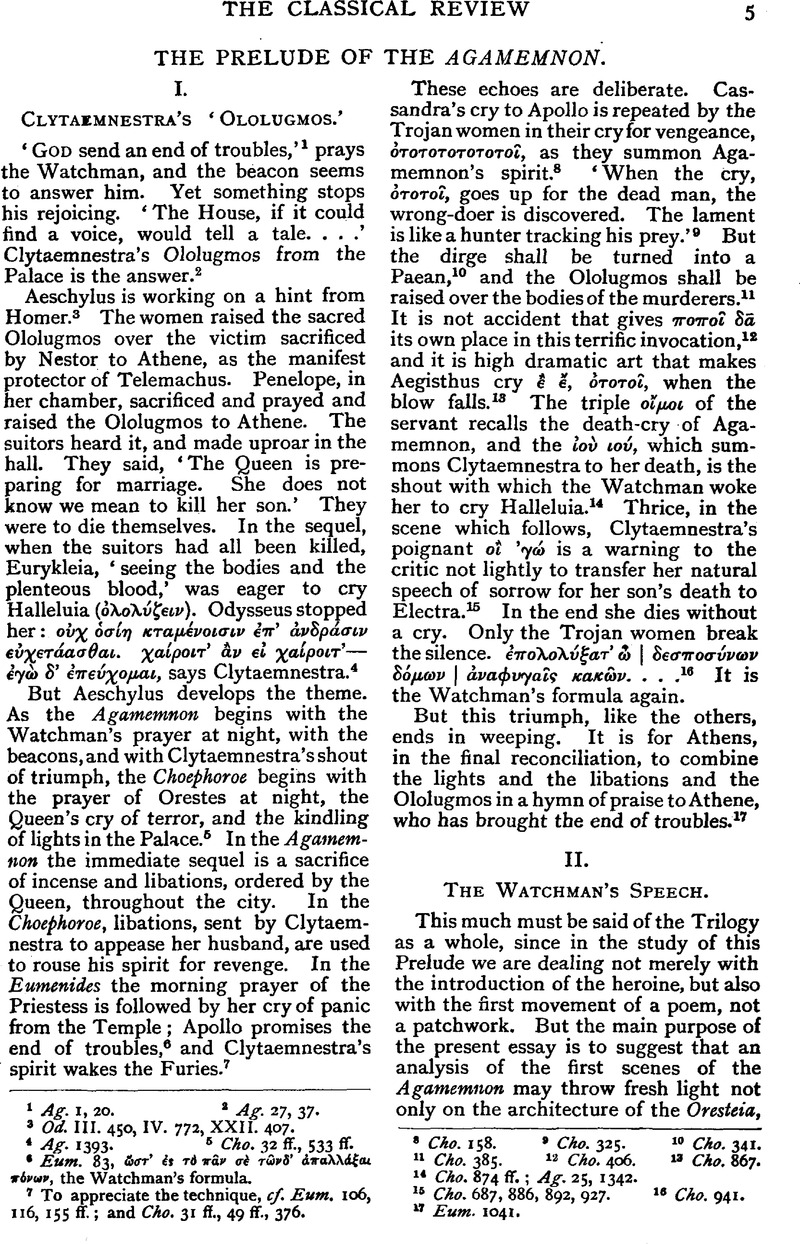No CrossRef data available.
Article contents
The Prelude of the Agamemnon
Published online by Cambridge University Press: 27 October 2009
Abstract

- Type
- Review Article
- Information
- Copyright
- Copyright © The Classical Association 1922
References
page 5 note 1 Ag. i, 20.
page 5 note 2 Ag. 27, 37.
page 5 note 3 Od. III. 450, IV. 772, XXII. 407.
page 5 note 4 Ag. 1393.
page 5 note 5 Cho. 32 ff., 533 ff.
page 5 note 6 Eum. 83, ![]() , the Watchman's formula.
, the Watchman's formula.
page 5 note 7 To appreciate the technique, cf. Eum. 106, 116, 155 ff.; and Cho. 31 ft, 49 ff., 376.
page 5 note 8 Cho. 158.
page 5 note 9 Cho 325.
page 5 note 10 Cho. 341.
page 5 note 11 Cho. 385.
page 5 note 12 Cho. 406.
page 5 note 13 Cho. 867.
page 5 note 14 Cho. 874 ff.; Ag. 25, 1342.
page 5 note 15 Cho. 687, 886, 892, 927.
page 5 note 16 Cho. 941.
page 5 note 17 Eum. 1041.
page 6 note 1 The technique is Homeric. Thus the Iliad begins, ‘Sing, Goddess, of the wrath of Achilles, son of Peleus,’ and of all the griefs it caused, ‘ in the accomplishment of the will of Zeus,’ beginning ‘ when first the son of Atreus quarrelled with the glorious Achilles.’
page 6 note 2 V. 1. Wilamowitz (following Hermann and others) prints a comma at π⋯νων. But the sense is, ‘ I have been praying for a whole year.’ μ⋯ν co-ordinates the sentence, not the first word only, to v. 8 and v. 20. For the order of the words and the use of κα⋯ ν⋯ν cf. Ag. 592–603 ![]() See also Ag. 40–67 (normal order, but a similar period), and Ag. 801–845, where the μ⋯ν clause is reinforced at 812 and 820, and answered, first partially at 821 τ⋯ δ' ⋯ς τ⋯ σ⋯ν φρ⋯νημα, and again at 835 rh. τ⋯ δ' αλλα, then wholly at 842 νῖν δ' ⋯ς μ⋯λαθρα. … Clytaemnestra's speech repeats this effect, 878 ἔμοιγε μ⋯ν δ⋯ …, 886 νῖν, 896 νῖν δ⋯ μοι, φ⋯λον κ⋯ρα, and finally, with terrible irony,
See also Ag. 40–67 (normal order, but a similar period), and Ag. 801–845, where the μ⋯ν clause is reinforced at 812 and 820, and answered, first partially at 821 τ⋯ δ' ⋯ς τ⋯ σ⋯ν φρ⋯νημα, and again at 835 rh. τ⋯ δ' αλλα, then wholly at 842 νῖν δ' ⋯ς μ⋯λαθρα. … Clytaemnestra's speech repeats this effect, 878 ἔμοιγε μ⋯ν δ⋯ …, 886 νῖν, 896 νῖν δ⋯ μοι, φ⋯λον κ⋯ρα, and finally, with terrible irony, ![]() 903 f. The same trick of order occurs with μ⋯ν—κα⋯—νῖν at 1330 ff.
903 f. The same trick of order occurs with μ⋯ν—κα⋯—νῖν at 1330 ff.
page 6 note 3 v.12. Wilamowitz denies that εὖτ' ἂν can be caught up by ⋯ταν δ⋯ (after the digression φ⋯βος γ⋯ρ …), and speaksof the philologische Unsitte of Headlam for defending this construction by quotations from late authors. But see Ag. 193 ff.  , corr. Stanley) εἶπε. Here is ‘resumptive δ⋯' twice illustrated, once with the main verb, once with the temporal ⋯πε⋯ following εὖτε and in a composition which recalls the structures of the prologue (beginning δ⋯κατον μ⋯ ἔτος, etc., and ending δ⋯ δ' ἔνθεν, etc.).
, corr. Stanley) εἶπε. Here is ‘resumptive δ⋯' twice illustrated, once with the main verb, once with the temporal ⋯πε⋯ following εὖτε and in a composition which recalls the structures of the prologue (beginning δ⋯κατον μ⋯ ἔτος, etc., and ending δ⋯ δ' ἔνθεν, etc.).
page 7 note 1 V. 69. I accept Casaubon's ὐποκα⋯ων, and regard οὒτε δακρ⋯ων as probably a gloss on οὔθ' ὑποκλα⋯ων(though Wilamowitz reads οὔτε δι' ⋯γν⋯ν: ‘θυμι⋯ματα accedunt ad ἒμπυρα et σπονδ⋯ς’. In view of Eum. 106–9 ![]() . I think that the right reading here is
. I think that the right reading here is ![]() conveying a suggestion of the vain attempt to escape consequences). The genitive denotes the substance of the offering (see Headlam on Ag.1394). The sense is ‘neither by burnt sacrifice, nor by libation of firelessofferings.’ Fireless offerings were normally offered to the chthonic powers, but sometimes in propitiation to the Olympians. Here the phrase glances at the sacrifice of Iphigeneia. Headlam's (posthumous) note appears to be made up of two inconsistent collections of material. In Ag. 1394, ‘ if it were possible to pour a libation of the appropriate material over this body,’ Headlam is right in insisting that libation over the dead is in fact the normal practice. He is wrong, however, in his interpretation of τ-αδ' in v. 1395. It means ‘blood,’ and catches up the thought of 1388 f.
conveying a suggestion of the vain attempt to escape consequences). The genitive denotes the substance of the offering (see Headlam on Ag.1394). The sense is ‘neither by burnt sacrifice, nor by libation of firelessofferings.’ Fireless offerings were normally offered to the chthonic powers, but sometimes in propitiation to the Olympians. Here the phrase glances at the sacrifice of Iphigeneia. Headlam's (posthumous) note appears to be made up of two inconsistent collections of material. In Ag. 1394, ‘ if it were possible to pour a libation of the appropriate material over this body,’ Headlam is right in insisting that libation over the dead is in fact the normal practice. He is wrong, however, in his interpretation of τ-αδ' in v. 1395. It means ‘blood,’ and catches up the thought of 1388 f.
The dramatic sequel of all this is the fatal offering to the dead in the Choephoroe, sent by Clytaemnestra because she hoped it would be ἂκος τομαῖον π⋯ματος (Cho. 518–19, 537).
page 8 note 1 See Lucas, , Class. Rev. XXXV., p. 28.Google Scholar


